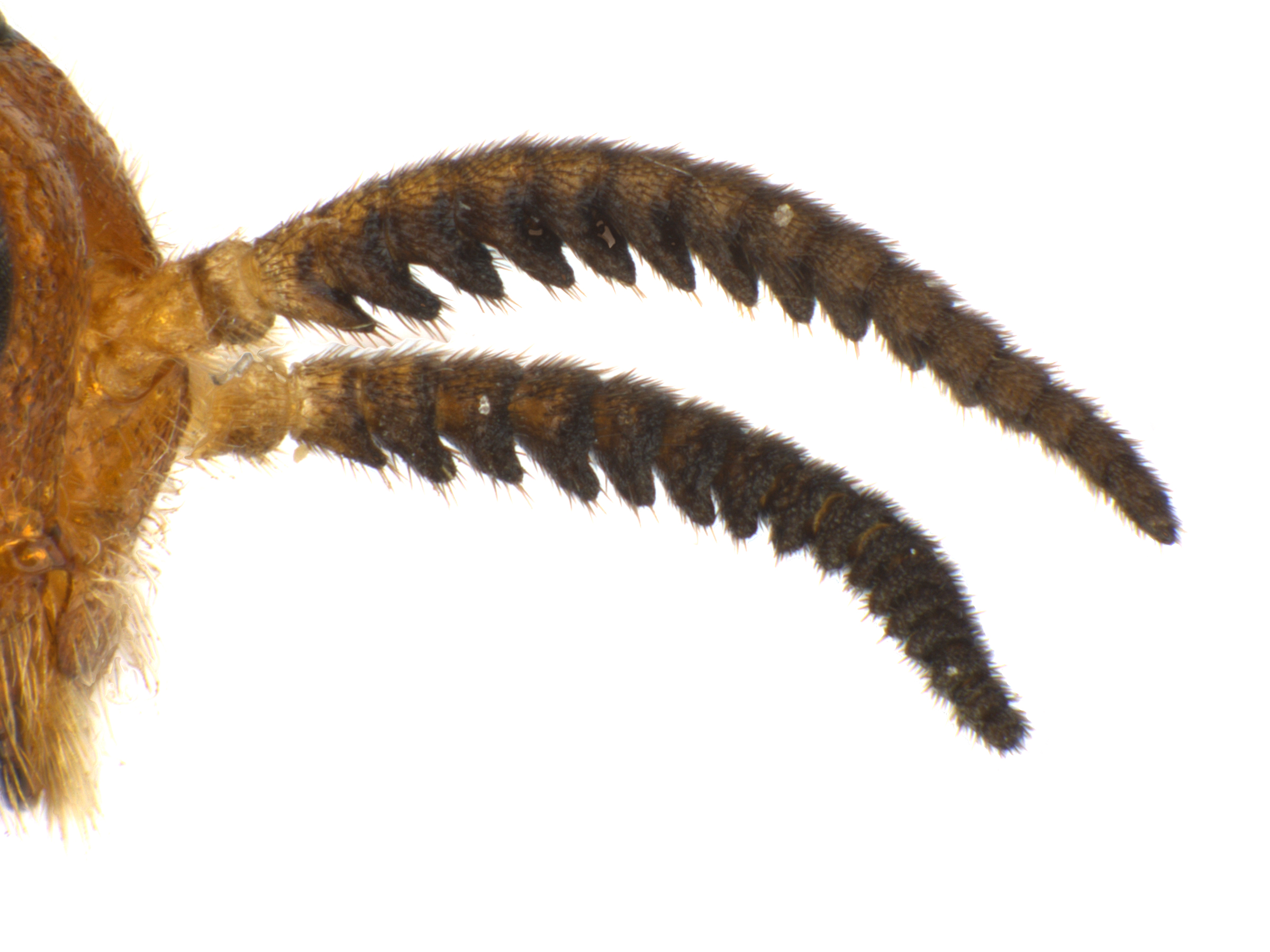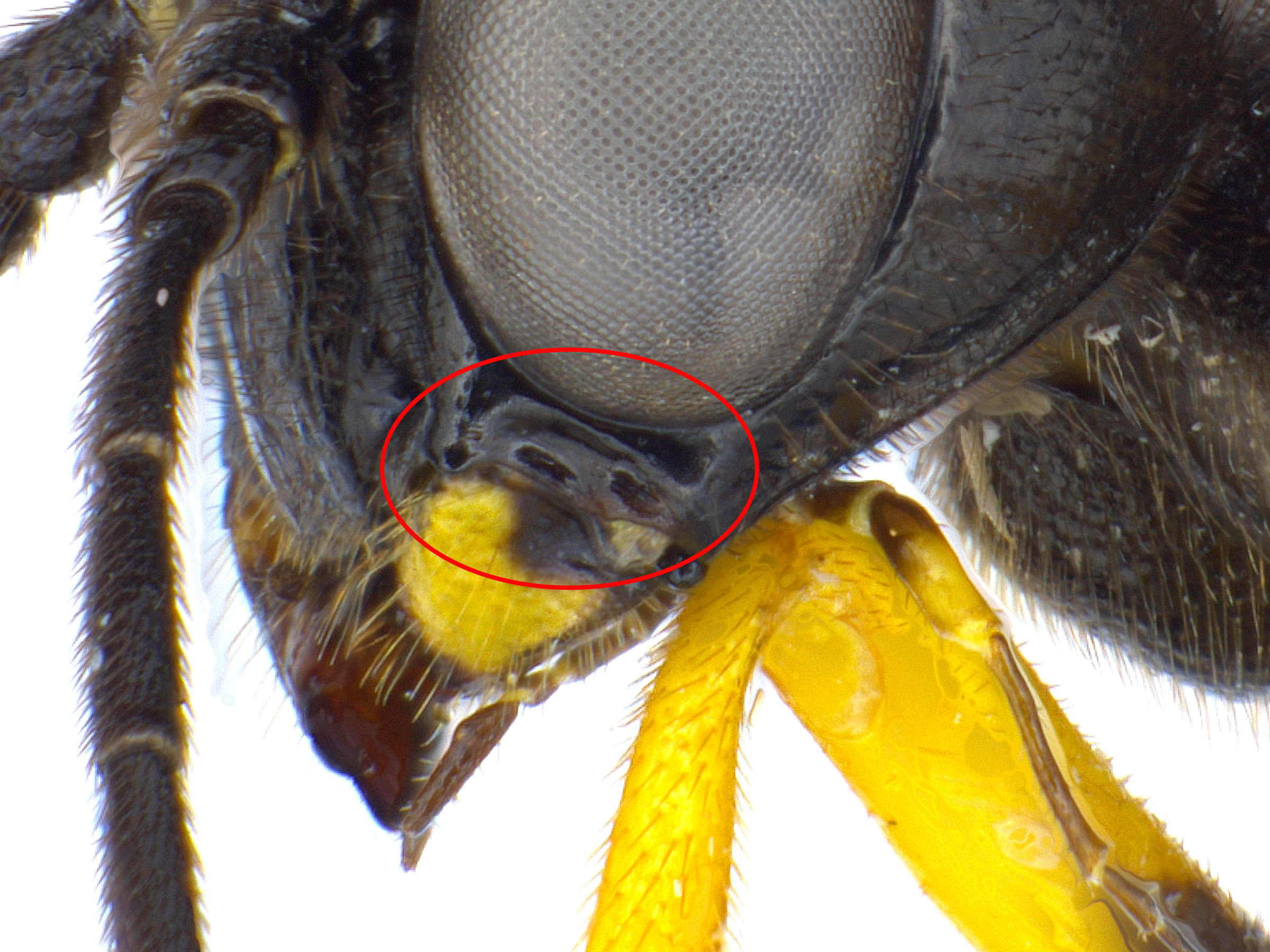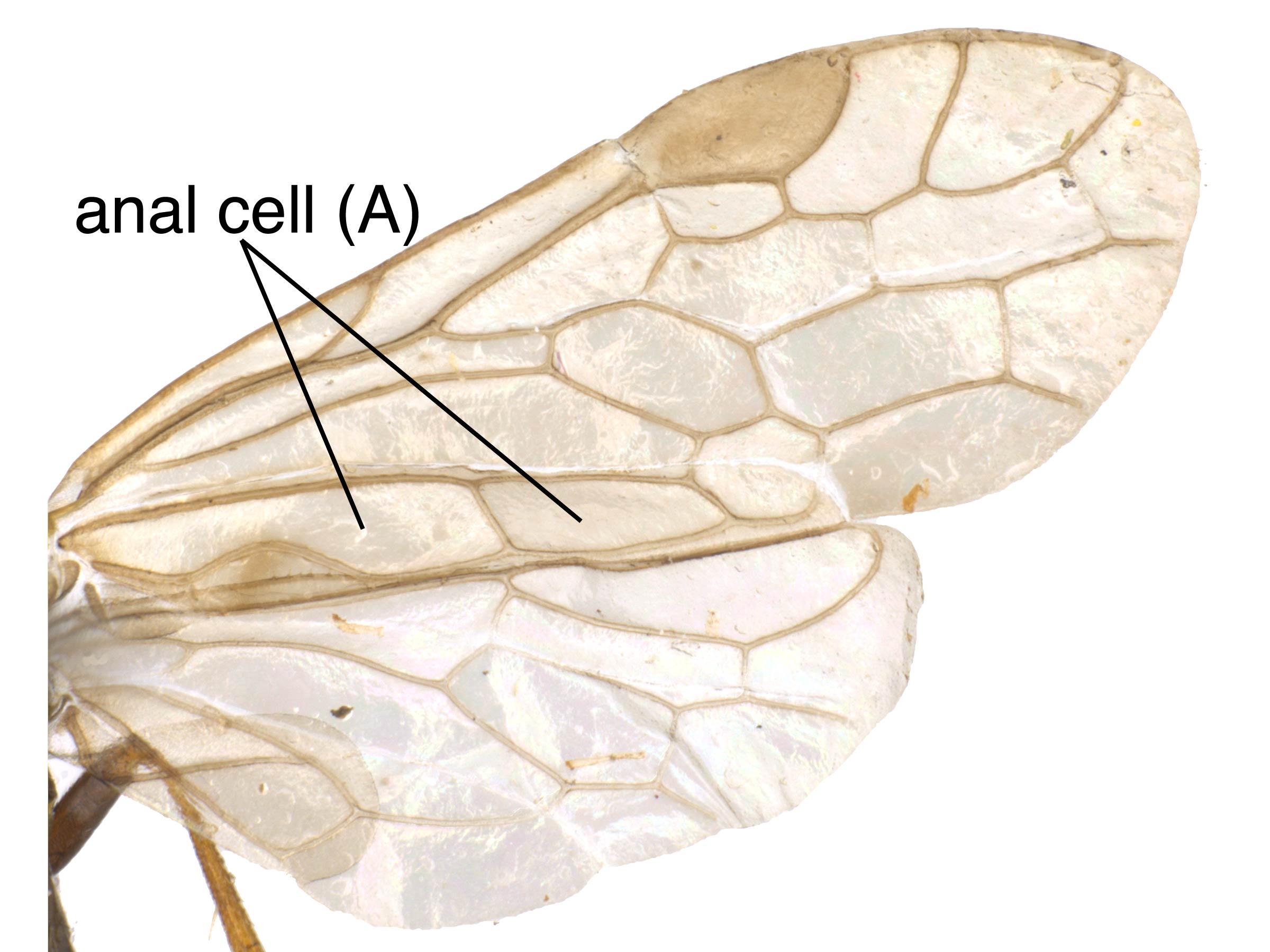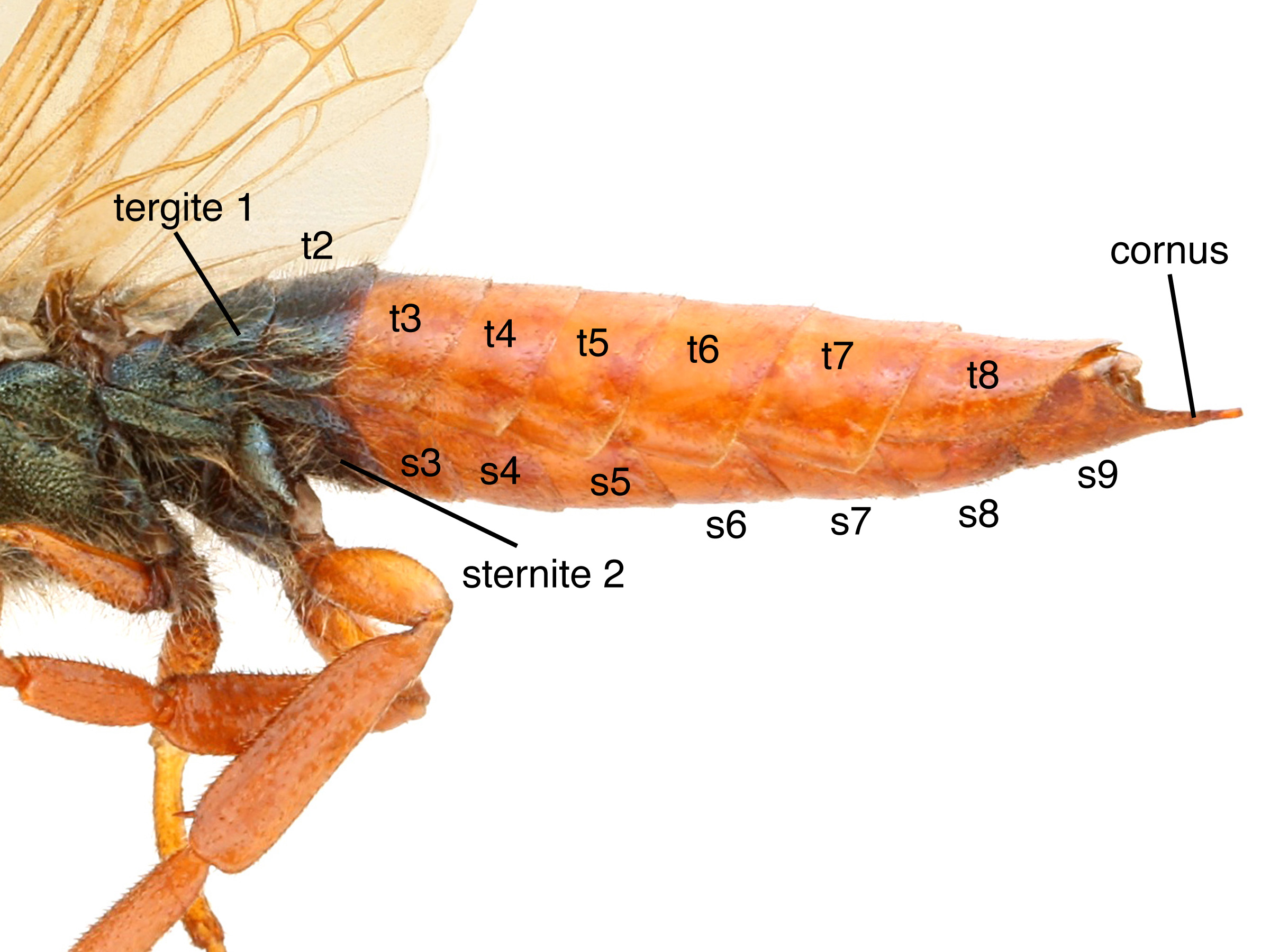Family: Tenthredinidae
Family common name: common sawflies
Subfamily: Selandriinae
Tribe: Adelestini
Genus: Adelesta Ross, 1937
Subgenera: none
The Tenthredinidae are the most species-rich family and are found throughout the world, in all continents but Antarctica. They are known as the “common sawflies.” They can generally be recognized by a cylindrical body and long, segmented antennaeantenna:
the sensory organ emerging from the front of the head, usually between the compound eyes and above the clypeus; includes the flagellum, scape and pedicel
 . Otherwise, they come in a variety of colors, sizes, and forms (Goulet 1992Goulet 1992:
. Otherwise, they come in a variety of colors, sizes, and forms (Goulet 1992Goulet 1992:
Goulet H. 1992. The genera and subgenera of the sawflies of Canada and Alaska: Hymenoptera. Symphyta. The insects and arachnids of Canada. Part 20. Agriculture Canada Publication.).
Sawflies in the Selandriinae subfamily are relatively small and slender. The range of Selandriinae is worldwide; it occurs on all continents except Antarctica (Goulet 1992Goulet 1992:
Goulet H. 1992. The genera and subgenera of the sawflies of Canada and Alaska: Hymenoptera. Symphyta. The insects and arachnids of Canada. Part 20. Agriculture Canada Publication.). It is the most common and diverse group of tenthredinids in tropical regions, particularly in Central America, South America, and Southeast Asia (Smith 1969eSmith 1969e:
Smith DR. 1969e. Nearctic Sawflies. II. Selandriinae: Adults (Hymenoptera: Tenthredinidae). Technical Bulletin, U.S. Department of Agriculture 1398: 1-48.). Selandriinae contains the only known sawflies that feed on non-vascular plants, specifically ferns (Smith et al. 2013Smith et al. 2013:
Smith DR, Janzen DH and Hallwachs W. 2013. Food plants and life histories of sawflies of the families Argidae and Tenthredinidae (Hymenoptera) in Costa Rica, a supplement. Journal of Hymenoptera Research 35: 17-31. https://doi.org/10.3897/JHR.35.5496). The subfamily can be distinguished from other subfamilies by wing venationvenation:
the network of veins on a wing
(Goulet 1992Goulet 1992:
Goulet H. 1992. The genera and subgenera of the sawflies of Canada and Alaska: Hymenoptera. Symphyta. The insects and arachnids of Canada. Part 20. Agriculture Canada Publication.).
Adelesta is monotypicmonotypic:
describes having only one representative; ex. a genus that includes only one species
and is the only North American genus of its tribe, Adelestini (Smith and Naito 2015Smith and Naito 2015:
Smith DR and Naito T. 2015. Studies on Adelestini (Hymenoptera, Tenthredinidae), particularly the long-tongued Nipponorhynchus Takeuchi of Japan. Journal of Hymenoptera Research 45: 1-14. https://doi.org/10.3897/JHR.45.5442). Adelesta nova is small, about 4.5 mm in length, and mostly black with white on the legs and distinctive serrateserrate:
toothed; often describing the ovipositor saw or antennae
 antennaeantenna:
antennaeantenna:
the sensory organ emerging from the front of the head, usually between the compound eyes and above the clypeus; includes the flagellum, scape and pedicel
 (Smith 1969eSmith 1969e:
(Smith 1969eSmith 1969e:
Smith DR. 1969e. Nearctic Sawflies. II. Selandriinae: Adults (Hymenoptera: Tenthredinidae). Technical Bulletin, U.S. Department of Agriculture 1398: 1-48.).
There is a single described extantextant:
in existence; opposite of extinct
species in this genus worldwide, and it is North American (Taeger et al. 2010Taeger et al. 2010:
Taeger A, Blank SM, and Liston AD. 2010. World Catalog of Symphyta (Hymenoptera). Zootaxa 2580: 1-1064.).
Subfamily characters
 vein Rs+M curved near intersection with veinvein:
vein Rs+M curved near intersection with veinvein: Sc+R (Smith 1969eSmith 1969e:
Sc+R (Smith 1969eSmith 1969e: vein M meeting Sc+R basalbasal:
vein M meeting Sc+R basalbasal: veins M and m-cu about parallel (Smith 1969eSmith 1969e:
veins M and m-cu about parallel (Smith 1969eSmith 1969e: vein 2r-m present (Goulet 1992Goulet 1992:
vein 2r-m present (Goulet 1992Goulet 1992:Genus characters
 margin straight (Smith 1969eSmith 1969e:
margin straight (Smith 1969eSmith 1969e: length about equal to the diameter of the front ocellusocellus:
length about equal to the diameter of the front ocellusocellus: (Smith 1969eSmith 1969e:
(Smith 1969eSmith 1969e: with 7 flagellomeres (Goulet 1992Goulet 1992:
with 7 flagellomeres (Goulet 1992Goulet 1992: sometimes appears somewhat serrateserrate:
sometimes appears somewhat serrateserrate: (Smith 1969eSmith 1969e:
(Smith 1969eSmith 1969e: as long as wide (Smith 1969bSmith 1969b:
as long as wide (Smith 1969bSmith 1969b: anal crossveinanal crossvein:
anal crossveinanal crossvein: (Smith 1969eSmith 1969e:
(Smith 1969eSmith 1969e: simple (Smith 1969eSmith 1969e:
simple (Smith 1969eSmith 1969e: 1 narrow medially, membranous area large (Goulet 1992Goulet 1992:
1 narrow medially, membranous area large (Goulet 1992Goulet 1992:Adelesta can be confused with similar species in the subfamily Selandriinae. It can be distinguished from most other genera by the almost serrateserrate:
toothed; often describing the ovipositor saw or antennae
 antennaeantenna:
antennaeantenna:
the sensory organ emerging from the front of the head, usually between the compound eyes and above the clypeus; includes the flagellum, scape and pedicel
 , centered anal crossveinanal crossvein:
, centered anal crossveinanal crossvein:
a crossvein that goes through the center of the basal anal cell
in the fore wingfore wing:
the anterior wing of each pair of wings; usually the largest wing of the pair
 , and the constricted first tergitetergite:
, and the constricted first tergitetergite:
a sclerotized segment of the tergum
 (Smith 1969eSmith 1969e:
(Smith 1969eSmith 1969e:
Smith DR. 1969e. Nearctic Sawflies. II. Selandriinae: Adults (Hymenoptera: Tenthredinidae). Technical Bulletin, U.S. Department of Agriculture 1398: 1-48., Goulet 1992Goulet 1992:
Goulet H. 1992. The genera and subgenera of the sawflies of Canada and Alaska: Hymenoptera. Symphyta. The insects and arachnids of Canada. Part 20. Agriculture Canada Publication.).
none
unknown
unknown
World: This genus is North American (Taeger et al. 2010Taeger et al. 2010:
Taeger A, Blank SM, and Liston AD. 2010. World Catalog of Symphyta (Hymenoptera). Zootaxa 2580: 1-1064.).
North America: Adelesta nova occurs in eastern Canada with records in Nova Scotia, New Brunswick and Quebec (Smith 1969eSmith 1969e:
Smith DR. 1969e. Nearctic Sawflies. II. Selandriinae: Adults (Hymenoptera: Tenthredinidae). Technical Bulletin, U.S. Department of Agriculture 1398: 1-48.). There are some records farther south in the Appalachian Mountains (Smith 2008bSmith 2008b:
Smith DR. 2008b. Sawflies and woodwasps (Hymenoptera: Symphyta) of Great Smoky Mountains National Park. Proceedings of the Entomological Society of Washington 110 (2): 379-390.).
Map data from: GBIF.org (29 October 2019) GBIF Occurrence Download Adelesta and the Smithsonian National Museum of Natural History Entomology Collection (USNM)
Details about data used for maps can be found here.